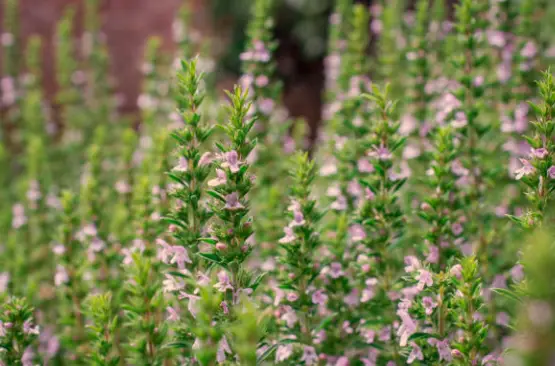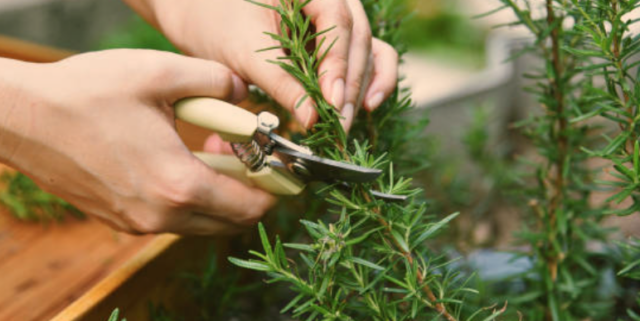One of the most widely used herbs in the world is rosemary. Its evergreen leaves, which resemble needles, have a zesty, woodsy flavor that goes well with roasted meats, bread, and even mixed drinks. However, did you know that rosemary may also provide pretty tiny flowers? Let us examine this remarkable plant’s capacity for flowering in more detail.
Do Rosemary Plants Flower?

Rosemary Plants
The short response is that rosemary plants do, in fact, blossom! In actuality, this perennial herb’s flowering stage is a crucial one in its life cycle. In many places, the fragrant purple, blue, pink, or white blooms first appear in the early spring and then reappear in the late fall.
What Do Rosemary Flowers Look Like?
Rosemary flowers grow in small clusters called racemes at the ends of the woody stems. Each flower is just 1/4 to 1/2 inch across but together they create a stunning visual display. The tiny blooms have the classic shape of many flowers in the mint family, with tubular bases and two “lips” on top.

Depending on the variety, rosemary flowers can be shades of deep blue, lavender-blue, purple, pink or white. Some cultivars, like ‘Golden Rain’, have flowers in a unique creamy yellow shade. The flowers also have contrasting brown, purple, or yellow stamens protruding from the center that add to their beauty.
No matter the color variety, all rosemary flowers share the same unmistakable aroma—that rich, resinous herbal scent we associate with the foliage but just a bit sweeter and more floral. You’ll definitely notice their enticing fragrance wafting through the garden when the plant is in full bloom.
Attracting Pollinators with Rosemary Flowers
Because they feed bees, butterflies, and other pollinating insects, rosemary blossoms are not only aesthetically pleasing but also have a significant ecological impact. Pollinators are drawn in by the plant’s sweet aroma and are enticed by the nectar-rich blossoms.
If you have rosemary plants in your garden or landscaping, you’ll likely notice a delightful buzz of activity around them when they’re flowering. Bees in particular can’t get enough of rosemary’s tiny but nectar-packed blossoms. This is a great plant for supporting your local pollinator population.
After successfully attracting pollinators like honeybees and certain butterflies, rosemary flowers will become pollinated and eventually produce seed. In the Mediterranean region, where rosemary originates, these seeds help the herb spread naturally in the wild. However, most gardeners propagate rosemary from cuttings rather than seed.
Flowering And Growth Habits
As you may have guessed, flowering is triggered by the lengthening days of spring in most climates. Rosemary needs at least 6–8 hours of direct sun exposure daily for the best blooming performance.
Some individual rosemary plants will only bloom in spring, then put their energy into foliage growth through summer and fall. Others may flower again later in the year if conditions are right. Regular pruning can actually encourage a second lush round of blooms in fall before the plant goes dormant for winter.
In climates with extended summer heat, rosemary may essentially stop flowering until temperatures moderate in the fall. But in coastal Mediterranean climates, they can bloom repeatedly over many months. Ideal temperatures for rosemary flowering are between 60 and 75°F.
Mature rosemary shrubs that are at least 2-3 years old tend to produce more abundant flowers than younger plants, though nursery plants may produce some blooms their first spring. A healthy, well-established rosemary in the perfect growing conditions can become completely smothered in purple, blue, or white flower clusters over a long spring blooming period.
The show doesn’t last forever, though. Bloom time is typically 4-6 weeks in the spring, maybe less in the fall. As the flowers start to fade, many people prune off the spent blossoms to keep the plants looking tidy. This pruning also removes seeds, as rosemary self-seeds easily from dried flower stalks if left in place.
Eating Rosemary Flowers
Did you know rosemary’s delightful aromatic flowers are actually edible? While the actual petals don’t have a strong flavor, the flower bases retain rosemary’s signature herbal taste and aroma. This makes rosemary blooms a wonderful ingredient for adding both flavor and visual appeal to all sorts of dishes.
You can harvest rosemary flowers just as the first buds start to open. Snip off entire flower stems or just the tender new blooms at the tops of the stems. Rinse them thoroughly to remove any dirt or pollinating insects that may be lingering inside.
Then use the fresh rosemary flowers as a garnish on everything from salads and soups to bread, pizza, cheese plates and cocktails. Their flavor is perfect for seasoning herbed butters, oils and vinegars too. Rosemary flowers can also be chopped and used, like the herb itself, to flavor both savory and sweet dishes.
Another option is to preserve the fresh floral taste and aroma by drying rosemary flowers. Hang the entire flower stem upside down in a warm, dry spot until completely dehydrated. Then store the dried blooms in an airtight container out of direct light.
Dried rosemary flowers will last for at least 6 months or longer in a cool pantry. Use them to make fragrant herbal teas, baked goods like scones and shortbread, homemade potpourri and bath products. The dried flowers retain their color well so they make beautiful decorations when used for things like wreath-making too.
Let’s not forget that, besides being edible themselves, rosemary flowers are also an excellent indicator that it’s about time to harvest the fresh herb as well! When blooms begin appearing in spring and fall, it’s the perfect signal to snip off some young, flavorful rosemary stems for cooking.
No matter how you use them, don’t miss out on the seasonal delights of rosemary’s captivating little flowers. Their vibrant colors, wonderful piney fragrance and gentle flavor elevate every dish. Savor their unique attributes while the blooms last!
Flowering Troubleshooting
What if your rosemary plant refuses to flower or only blooms sporadically? There are a few common reasons this can happen:

Do Rosemary Plants Flower
Age: It can take 2-3 years before rosemary reaches full maturity and blooms prolifically each spring. Be patient with young plants.
Temperature: If temperatures are too cold in spring or too hot in summer, flowering may be delayed or skipped entirely. Rosemary likes it between 60 and 75°F during bloom season.
Sunlight: At least 6 hours of direct sunlight daily is required for good flowering. The morning sun is ideal. Rosemary grown in too much shade often won’t bloom well.
Pruning: Regular pruning towards the beginning of spring actually encourages lusher blooms and repeat flowering in the fall.
Water: Rosemary needs consistent moisture during its spring and fall bloom seasons. But don’t overdo it, as wet roots can prevent flowering too.
Fertilizer: Using a balanced, slow-release fertilizer in early spring helps give plants the nutrients needed for prolific blooming.
Your rosemary should repay you with beautiful, fragrant flowers every spring, as long as you give it the perfect growing conditions: morning light, temperate temperatures, well-drained soil, and appropriate trimming. If flower production is low over the first few years, just have patience. Bigger, more seasoned rosemary bushes will provide an amazing display of vibrant flowers!




